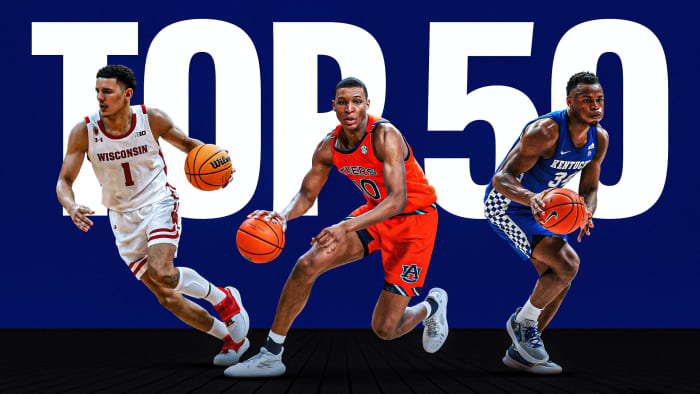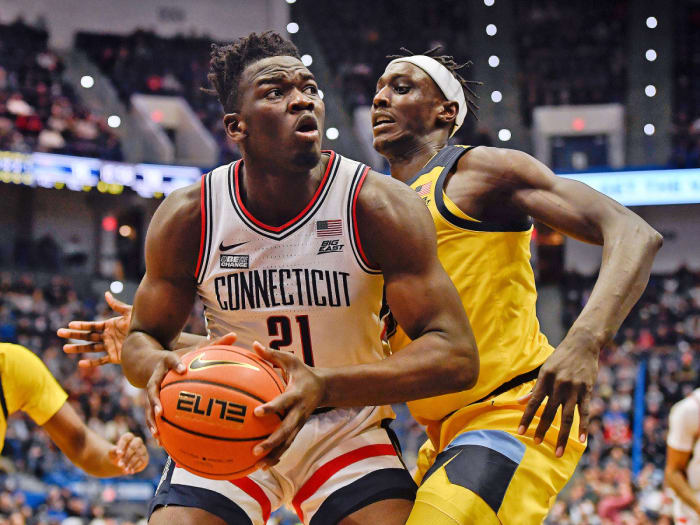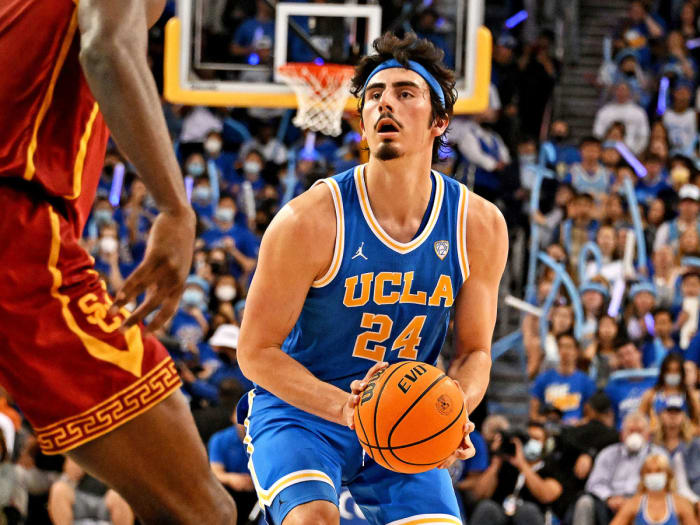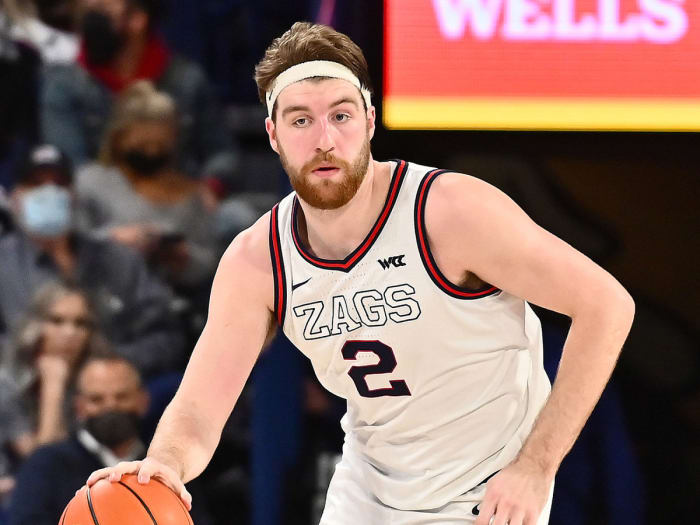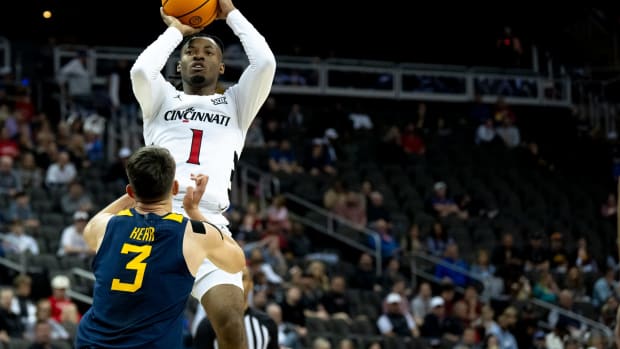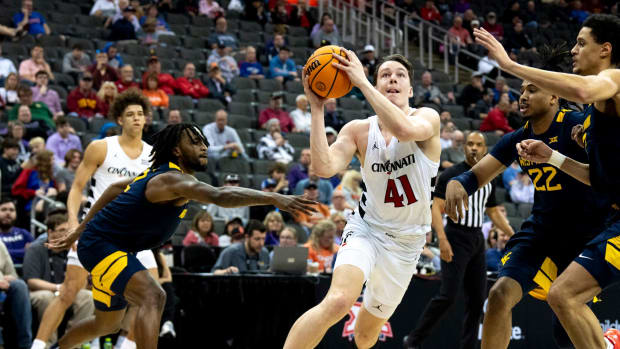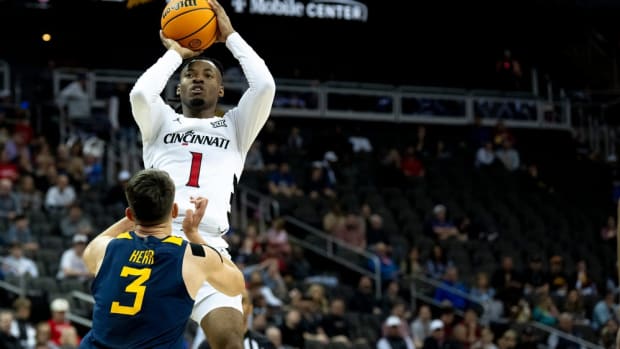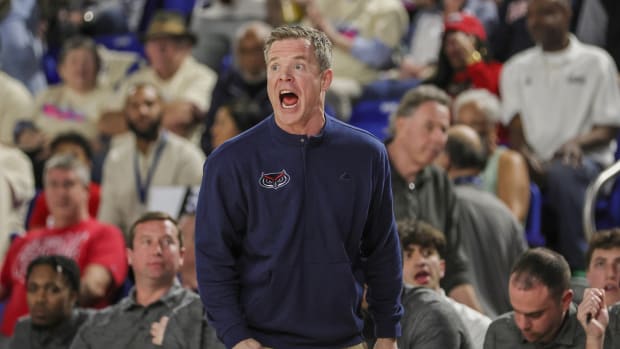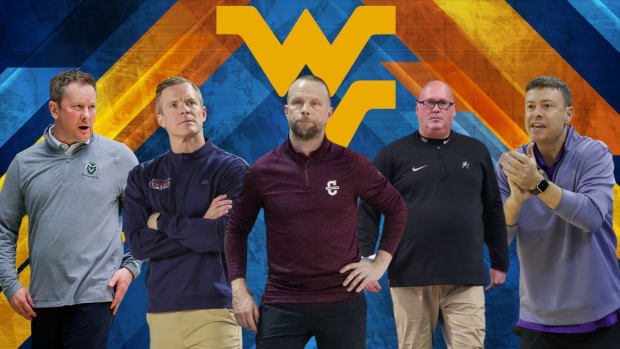The Top 50 Men’s Players of the 2021–22 College Basketball Season
We’re one week away from the first full day of the 2022 men’s NCAA tournament, and the hype is building. But before we get to brackets, upsets and seedings, we’re setting the stage with the names you need to know for the next month.
Heading into March Madness, Sports Illustrated has ranked the top-50 men’s players of the regular season, a list that was previously headed by the likes of Zion Williamson, Obi Toppin and Luka Garza. This year’s ranking was determined by SI’s Jeremy Woo and Kevin Sweeney, and took into account everything from statistics, year-to-year growth, importance to team and overall performance.
First, we’ll highlight five players that just missed the cut for our top 50. Then, the list will count down from No. 50 all the way to No. 1.
Honorable Mentions: Kellan Grady (Kentucky), James Akinjo (Baylor), Hunter Maldonado (Wyoming), Jaden Shackelford (Alabama), Fabian White Jr. (Houston)
All stats as of Wed., March 9
SI’s top-50 men’s players in 2021–22:
50. Jaylin Williams, Arkansas
Williams has been a uniquely valuable cog for Arkansas and one of the more underrated bigs in college basketball: He’s an efficient scorer, smart passer and screener, a plus defensive rebounder and has given the Razorbacks a consistent paint presence. He’s the type of player you need to watch closely to fully grasp his value, but Arkansas figures to be a dangerous team in March due in no small part to the problems he creates for defenses. Presuming he returns next year to a team bringing in star freshmen Nick Smith and Jordan Walsh, things could get spicy. —Jeremy Woo
49. Kendric Davis, SMU
The primary reason SMU is in the hunt for an NCAA tournament bid entering Selection Sunday? Its star senior guard. He may be undersized, but there aren’t many point guards in college hoops better than Davis, who has had an impressive career in his three years at SMU after transferring across town from TCU. He’s an excellent playmaker off the bounce and is one of the best pick-and-roll maestros in the sport, though his assist numbers are down from last season because SMU has added more ballhandlers. —Kevin Sweeney
48. Julian Champagnie, St. John’s
One of the most talented shotmakers in college hoops, Champagnie’s 6'8" frame and high release point make him one of the more unguardable wings in the sport. His shooting percentages have regressed somewhat after making a blistering 38% from distance in 2020–21, but he’s still the Big East’s second-leading scorer and capable of exploding from beyond the arc at any time. He’s also a good rebounder and makes plays defensively in Mike Anderson’s swarming scheme. —K.S.
47. Malachi Smith, Chattanooga
Just four players in the last 30 years in men’s college hoops have averaged at least 20 points, six rebounds and three assists while shooting 50% from the field and 40% from three: George Hill, Kerry Kittles, Fred Hoiberg and Malachi Smith. The first three names all carved out solid careers in the NBA. Could Smith? He has been the biggest reason for Chattanooga’s great season and is one of the best players not just in mid-major basketball, but college basketball as a whole. —K.S.
46. Jamaree Bouyea, San Francisco
Five years ago, San Francisco was Bouyea’s only Division I scholarship offer. That leap of faith in the prospect has paid off big-time for San Francisco, first for Kyle Smith and now for Todd Golden. Not only has the fifth-year guard become one of the nation’s best floor generals, but he has led the Dons to the doorstep of their first men’s NCAA tournament appearance since 1998. Bouyea is as crafty as they come when creating in ball screens and also has near-limitless range from beyond the arc. —K.S.
45. Kennedy Chandler, Tennessee
Chandler has more or less lived up to his billing as the top freshman point guard this season, giving Tennessee stable play and helping connect a weirdly constructed roster. He’s extremely fast in the open floor, finds teammates off his drives and plays hard defensively in spite of his small stature. He’s a streaky shooter and has had some freshman moments, but there’s been more good than bad, and the Vols have remained among the SEC’s top teams. —J.W.
44. Trent Frazier, Illinois
Watching Frazier’s role evolve over his five seasons in Champaign has been fun to watch. He’s done everything Brad Underwood could have asked him to do and more, going from primary scoring option to defensive-minded three-point specialist to now, as a COVID-19-year senior, often running the point for the Illini. Frazier is also one of the best defensive players in the sport and is known around the league for his ability to lock up some of the Big Ten’s best perimeter players. —K.S.
43. Orlando Robinson, Fresno State
Coaches around the Mountain West rave about Robinson, a 7-footer who is among the most productive bigs in the nation. He has a polished offensive game that includes the ability to space the floor, score in the midrange and finish on the block, and he has improved as a passer and decision-maker in his junior season after testing the NBA waters last offseason. And despite not having the most talented supporting cast around him, he has lifted Fresno to a top-65 ranking on KenPom. —K.S.
42. Adama Sanogo, UConn
In his sophomore season in Storrs, Sanogo has blossomed into one of the better post scorers in college basketball. His combination of power and polish on the block makes him incredibly hard to defend, and he has been incredibly productive despite dealing with an abdominal strain in December. In addition to his scoring ability, Sanogo is also a tenacious rebounder, with six games with 15 or more rebounds to his name this season —K.S.
41. Hunter Dickinson, Michigan
Michigan hasn’t lived up to the lofty expectations heaped upon the Wolverines in the preseason, but Dickinson hasn’t been the problem. He has had to work harder for his buckets this year without the luxury of elite spacing and playmakers surrounding him on the perimeter, but has still averaged 20 points and eight rebounds per contest in Big Ten play and has improved significantly at passing out of the post when opponents send double teams. —K.S.
40. Kendall Brown, Baylor
The pairing of Brown and Jeremy Sochan gives Baylor a better mix of athleticism, size and smarts in the frontcourt than basically any other team. Neither plays like a freshman. And Brown’s comfort level as a cutter, finisher and rangy defender has made him highly impactful, despite his limited ability to handle the ball and occasional hesitance to shoot. He’s been highly efficient, a plus on both ends of the floor and gives the Bears a notable athletic advantage in most matchups. —J.W.
39. Jeremy Sochan, Baylor
The schematic versatility Sochan offers Baylor isn’t obvious from his stats, but there are games in which he’s been the Bears’ most impactful player. He’s agile enough to defend basically anybody and skilled enough to moonlight as a ballhandler in a pinch, affording Baylor some unique tricks up its sleeve when the situation calls for it. His feel for positioning, moving the ball and picking his spots is well beyond his years, and his time in Waco, unfortunately for Baylor, will be shorter than expected. —J.W.
38. Jake LaRavia, Wake Forest
LaRavia and fellow transfer Alondes Williams have been the two biggest reasons for Wake Forest’s impressive turnaround in 2021–22. He’s one of the nation’s best power forwards, a versatile threat who can handle the ball, make shots and distribute while also being strong on the glass and athletic enough to guard in space. LaRavia also lives at the free throw line, ranking in the top 50 nationally in free throw rate and knocking down more than 78% of his shots when he gets to the line. —K.S.
37. Bryson Williams, Texas Tech
There are several candidates for this list from Texas Tech, one of the most balanced teams in the country. A sixth-year player who has also made stops at Fresno State and UTEP, Williams leads a top-15 Red Raiders team in scoring and has made a major impact in what will be his lone season in Lubbock. The big man leads Tech in scoring, shoots 44% from three and is steady on the glass. —K.S.
36. Trayce Jackson-Davis, Indiana
Success hasn’t quite followed for the Hoosiers the way Jackson-Davis had hoped when he returned for his junior season in Bloomington, but TJD remains one of the nation’s most productive big men. In addition to being a gifted post scorer, Jackson-Davis has improved this season as a passer and shot-blocker. If Jackson-Davis wants to make his NCAA tournament debut, he’ll need to carry the load in the Big Ten tournament for a Hoosier team that’s squarely on the bubble heading into Championship Week. —K.S.
35. Zach Edey, Purdue
The other cog in Purdue’s two-headed center monster, Edey is perhaps the hardest player to guard in college basketball because of his gigantic 7'4" frame. Edey’s more than just big—he has good footwork and a soft touch on the block, and does an excellent job of keeping the ball high to prevent turnovers in the face of the near-constant double teams he faces. He has his issues defensively, but his skill down low is enough to earn him this ranking. —K.S.
34. AJ Griffin, Duke
Following a slow start as he returned from injury and carved out a role, Griffin rediscovered himself in January and has shot a torrid 48% from three in the regular season. That’s been a critical development for Duke, which has sorely needed that floor spacing component. Coupled with the size he provides defensively on the wing, Griffin has been one of the better role players in the country—and one with the individual ability to be more than that when the moment calls for it. —J.W.
33. Justin Moore, Villanova
There’s nothing flashy about Moore’s game, but the junior is one of the more consistently productive wings in the sport. His sturdy 6'4" frame allows him to guard bigger players, which is essential for a slightly undersized Villanova team that loves to switch defensively. He also hits 36% from three and is the Wildcats’ best bet when they need to create something off the bounce in isolation. —K.S.
32. Izaiah Brockington, Iowa State
Brockington’s outstanding season has been one of the better stories of the season. After transferring twice, the Philadelphia native has finally found a home in Ames and has been a huge reason for ISU’s remarkable turnaround. The Cyclones, which won just two games all of last season, are well positioned to go dancing thanks to Brockington, who is averaging more than 17 points and seven rebounds while shooting 40% from deep. —K.S.
31. TyTy Washington Jr., Kentucky
Washington’s modest freshman-year numbers have lightly disguised his impact at Kentucky, where his feel for moving the ball and timely shotmaking has given the Wildcats an offensive boost. Even when not scoring much, his value as a connective piece has meant a lot to the Wildcats, who in some ways make for an odd collection of parts around Oscar Tshiebwe. Washington’s ability to play with and without the ball in his hands while helping direct play makes him one of the more broadly useful guards in the sport. —J.W.
30. Trevion Williams, Purdue
One of the most unique players in the country, Williams brings a vastly different skill set to center platoon partner Edey. He’s perhaps the best passing big man in the country, capable of whipping flashy assists to open cutters in Purdue’s motion offense. He’s also an excellent rebounder and his quick feet help him defend in space far better than he has in years past. He’s turnover-prone and struggles at the free throw line, but if he played more normal minutes he’d likely be in the mix for All-American honors. —K.S.
29. Jaime Jaquez Jr., UCLA
Jaquez has spent much of this season playing through injury and didn't enjoy the full breakout some hoped for. Still, he’s come on strong at the end of the season and could be poised for another big March run. He’s one of the toughest and hardest-working players anywhere, and he marries that with a versatile offensive skill set. His experience and poise make a streaky UCLA team dangerous when it counts. —J.W.
28. Justin Lewis, Marquette
Shaka Smart’s immediate revival at Marquette has come in large part due to Lewis’s emergence as a knockdown shooter, taking a huge leap from a freshman year in which he was a nonfactor from three. He’s become one of the better players in the Big East, willing to let it fly from three, bang against smaller defenders and also add some value on the glass. While he can be streaky, the Golden Eagles wouldn’t be a tourney team without him. —J.W.
27. Adam Flagler, Baylor
Flagler stepped into a bigger role this season and has been one of the most reliable guards in college basketball, stabilizing Baylor’s backcourt in a combo role and excelling as a shooter and secondary playmaker. His toughness and consistency have played a huge part in the Bears’ sustained success amid an influx of new talent. Although he may not get the credit he really deserves, there’s not a team in the country Flagler wouldn’t make better. His penchant for hitting big shots should come in handy this month. —J.W.
26. Christian Koloko, Arizona
Arizona has the nation’s second-best two-point defense, and Koloko is the primary reason. He’s perhaps the nation’s best rim protector, using his ridiculously long arms and great timing to block shots at an extremely high rate. And even when he doesn’t get his hands on a shot, he’s still impacting nearly every shot around the rim thanks to his length and instincts. Plus, he has polished his skills at the basket offensively to become a reliable piece in one of the nation’s best offenses. —K.S.
25. Armando Bacot, North Carolina
If not for Oscar Tshiebwe’s otherworldly rebounding totals this season, there’d likely be a lot more conversation about the season Bacot has put together in Chapel Hill. He’s on his way to setting Carolina’s single-season rebounding record and would be passing Brice Johnson, who played in 40 games in his record-setting season. Defensive issues have plagued the Tar Heels in Hubert Davis’s first year at the helm, but the Heels still look poised to go dancing thanks to the double-double machine that is Bacot. —K.S.
24. Andrew Nembhard, Gonzaga
He may average only 11.5 points per game, but there’s no question that Nembhard is among the premier floor generals in college basketball. He’s the heartbeat of the No. 1 Zags, so critical in getting the Bulldogs out in transition where they are so dangerous. Nembhard is also terrific operating in ball screens, particularly at putting defenders in a bind with Drew Timme or Chet Holmgren screening for him. —K.S.
23. Collin Gillespie, Villanova
The consummate point guard and winner, there’s nothing flashy about Gillespie’s game. But any coach in college hoops would gladly take Gillespie on his team because the veteran playmaker is an elite shooter, great decision-maker and an excellent rebounder for his position. His steady-handed play has the Wildcats in the top 10 nationally and will have him remembered among the great point guards to play under Jay Wright at Villanova. —K.S.
22. JD Notae, Arkansas
Much has been made this season about the dearth of elite guards in college hoops, but Notae qualifies for that short list. The Razorbacks star is one of the best in the nation at creating his own shot off the bounce, as evidenced by the 30 points he poured in against Kentucky and the 28 he scored against Auburn in February. It’s no coincidence that Arkansas found its rhythm after a disastrous stretch in December and early January once it decided to just put the ball in Notae’s hands and let him work. —K.S.
21. Mark Williams, Duke
Williams became a star in his role this season, providing elite rim protection and steady rebounding while putting away pretty much every easy opportunity in the paint. His length, hands and mobility allow him to impact the flow of games without touching the ball that often, and his reliability has given Duke a crucial interior presence on a team that’s otherwise perimeter-oriented. If he played more minutes, his points and rebounds would be gaudier, but Williams’s impact is easy to see on any given night. —J.W.
20. Wendell Moore Jr., Duke
Moore has become Duke’s bellwether and rejuvenated his career in the process, playing a jack-of-all trades role that’s seen him moonlight at point guard and tackle tough defensive assignments. He’s become a valuable, unique player, capable of stepping up as a distributor, knocking down threes and putting pressure on defenses in different situations as a ballhandler. His teammates may receive more of the spotlight, but without Moore’s individual leap, Duke doesn’t win the ACC. —J.W.
19. Alondes Williams, Wake Forest
The Oklahoma transfer has put together a historic statistical season in his only year in Winston-Salem. If the season ended today, he’d become just the 10th men’s player since 1992 to average at least 19 points, six rebounds and five assists per game for a season, joining an exclusive list that includes the likes of Penny Hardaway, Denzel Valentine and Ayo Dosunmu. Williams’s impact on Wake Forest can’t be overstated, helping turn a program that won just six games last season into a likely NCAA tournament team in 2021–22. —K.S.
18. Christian Braun, Kansas
The Robin to Ochai Agbaji’s Batman in Lawrence, Braun has really expanded his game in his junior campaign. His first two years at Kansas, he was primarily used as an off-ball shooter and took 60% of his shots from beyond the arc. This year, he has improved as a slasher and often been looked to as a creator off the bounce in addition to his ability to make outside shots. He’s the type of four-year player Bill Self has built around in his time at KU and is a big reason the Jayhawks shared the Big 12 title this season. —K.S.
17. David Roddy, Colorado State
One of the most unique players in the country, Roddy has helped elevate the Rams program to new heights alongside star point guard Isaiah Stevens. Roddy is built like a defensive end, but pairs that monstrous frame with quick feet and impressive playmaking skills that allow him to play pretty much any position on the court. He’s also shooting a blistering 47% from three and has hit huge shots in big moments for the Rams this season. He’s the type of talent that can win you a game or two in March. —K.S.
16. Tari Eason, LSU
Eason has built a convincing statistical profile while coming off the bench for LSU, racking up steals and blocks in the flow of the game and contributing with his energy on the offensive end. His production hasn’t always come in concert with team success—the Tigers’ questionable guard play has capped their success—but it’s been consistent, and he's maintained it in conference play. He’s not individually skilled enough to close games in the traditional star sense, and he still fouls too much, but Eason’s athleticism and aggressiveness has, more often than not, given his team a chance. Considering he was an under-the-radar transfer from Cincinnati, it would be hard to ask for more. —J.W.
15. Johnny Juzang, UCLA
After being one of March’s biggest stars in 2021, Juzang has seemingly flown under the radar in 2022. Still, the junior is averaging 17 points per game and doing it efficiently on a team positioned for a top-four seed in the NCAA tournament. He’s one of the sport’s best tough-shot makers, a skill he showcased over and over again during UCLA’s run to the Final Four last season. Can he and Jaquez lead the Bruins to March glory one more time? —K.S.
14. Azuolas Tubelis, Arizona
Often overshadowed by Bennedict Mathurin’s flashier game, Tubelis may be one of the more underappreciated stars in college hoops. He’s a perfect fit in Tommy Lloyd’s up-tempo offense because of his ability to grab and go, and his passing ability is extremely valuable in the high-low actions Lloyd likes running in the halfcourt. Advanced metrics love Tubelis’s impact on the game, and it’s no coincidence that two of Arizona’s three losses have come when Tubelis played 15 minutes or less due to foul trouble. —K.S.
13. Drew Timme, Gonzaga
Timme was most people’s choice for National Player of the Year in the preseason. While he hasn’t quite lived up to that lofty billing, he’s still a worthy All-American candidate and one of the best post scorers in college basketball. Gonzaga’s team construction this season playing two bigs gives Timme slightly less room to operate on the block, but he’s still lethal in one-on-one situations with his array of post moves and tremendous touch. —K.S.
12. Walker Kessler, Auburn
Transferring from North Carolina proved a terrific decision for Kessler, who’s emerged as the most dominant defensive player in the sport. He leads the country in block rate (19.1%!), recorded five or more blocks 13 times in the regular season, and provided Auburn with enough backbone to roll to an SEC title, pairing nicely with Jabari Smith. He’s a game-changer that most opponents haven’t been able to account for, and enables the Tigers to play their high-pressure scheme, knowing there’s always cover in the paint. His season has quietly been historic. —J.W.
11. Paolo Banchero, Duke
Though Banchero hasn’t been quite as dominant as his preseason fanfare implied he’d be, he’s had a successful freshman year as the focal point of a good Duke team. His size, strength and skill presents a difficult mismatch for every opponent, made tougher by his ability to bring the ball up and play out of different spots on the floor. The attention he draws opens things up for everyone else on his team, and his effort and production has been mostly consistent. He’s a streaky shooter and could be better defensively, but Banchero is gifted enough to be the best player on the floor in any given game, which Duke will need him to be in March. —J.W.
10. Bennedict Mathurin, Arizona
Mathurin has been the star of one of college basketball’s most entertaining teams: he’s at his best playing in space and running in transition, and Arizona has done that extremely well. He’s expanded his game as a scorer and shooter as a sophomore, and proven capable of handling heavy volume on a consistent basis. Mathurin has also improved his passing, enabling him to better impact games when his shot isn’t falling. The Wildcats are an ensemble cast, but they wouldn’t be outgunning teams on the regular without him. —J.W.
9. Jaden Ivey, Purdue
Not only is Ivey one of the most athletic players in college basketball, but on his good nights, he’s been among the most dominant. There have been some low points, and his tendency to float in and out of games can be frustrating, but when you get down to it, few players anywhere can match his sheer talent. Ivey can get into the paint with his right hand whenever he wants and has bolstered his offensive output with a mostly reliable three-point shot, making him a tough cover—when he’s locked in and at his best, there’s not much you can do about it. How far Purdue goes in March hinges on what version of Ivey shows up. —J.W.
8. E.J. Liddell, Ohio State
Some quiet games down the stretch in the midst of some late-season struggles for the Buckeyes kept Liddell out of the top five, but the junior forward has put together a remarkable season to keep OSU in the top 25 for much of the season. With Justice Sueing sidelined, Liddell has had to take on an even larger role than expected, serving not only as the team’s top scorer, rebounder and shot-blocker but also ranking second on the Buckeyes in assists. He has gotten better every season of his college career to become one of the sport’s premier players and a likely first-round draft choice this summer. —K.S.
7. Ochai Agbaji, Kansas
The jump offensively Agbaji has made in his senior season after testing the NBA waters last spring and summer has been incredibly impressive. He’s now one of the best shooters in the sport, and while he isn’t the most explosive creator off the dribble, he improved his game overall as a scorer to help lead the Jayhawks to a share of the Big 12 regular-season crown. With a strong finish, he’ll become the first KU player since Frank Mason to average 20 or more points. —K.S.
6. Chet Holmgren, Gonzaga
Holmgren’s unique brand of dominance has given Gonzaga a consistent defensive backbone all season, taking away space in the paint and eating up wayward shots with ease. He’s also been impossibly efficient, shooting 73.4% on twos and 41.2% on threes, numbers that are pretty much unheard of, particularly for a 7-footer. The only real knock on Holmgren this season is that he hasn’t always been as dominant against better competition. But there’s nobody in the college game quite like him, and what he’s accomplished statistically is historic. —J.W.
5. Jabari Smith, Auburn
When Smith has it going, he can change a game on both ends faster than any player in the country, with a near-unblockable jump shot, easy three-point range and a level of confidence and focus beyond his years. Couple that with the fact he’s a mobile, aggressive defender at 6' 10" and you’ve got a truly special talent—not to mention the fact that he’s one of the youngest players in the nation. Auburn has tried to manage his minutes carefully, but as the games have gotten bigger, Smith’s role in the offense has grown, and his play has trended up entering March. He gives the Tigers a chance to beat just about anybody. —J.W.
4. Kofi Cockburn, Illinois
There’s something to be said for living up to lofty expectations, and Cockburn has certainly done that. After earning consensus All-American honors in 2020–21, Cockburn’s late decision to return to Champaign has lifted the Illini to a top-20 national ranking. He’s the only player in the country averaging 20-plus points and 10-plus rebounds, and the 7-footer has improved his conditioning to allow himself to stay on the floor for 30 minutes per game. Cockburn will likely top 1,500 career points sometime during the Big Ten tournament in what would be yet another milestone in his storied career in Champaign. —K.S.
3. Keegan Murray, Iowa
Murray spent last season playing sidekick to Luka Garza and Joe Wieskamp, and while keen observers knew he was under-utilized, nobody could have reasonably predicted the breakout year in store. He’s been nothing short of prolific, enabling Iowa to far exceed its expectations, and he’s scored with a better mix of volume and efficiency than anyone in the country, while also chipping in on the glass and on the defensive end. Consider the monster season Garza had last year, and understand that Murray has been every bit as good. —J.W.
2. Oscar Tshiebwe, Kentucky
One of the most prolific rebounders in modern college basketball history, Tshiebwe’s presence in Lexington has been the single biggest reason for Kentucky’s huge turnaround. The impact of his dominance on the glass can’t be overstated—the attention he commands on the boards leads to tip-dunks for teammates on one end and the chance to get out in transition on the other. His nose for the ball alone earns Kentucky countless extra possessions and makes the lives of its talented trio of guards much easier. —K.S.
1. Johnny Davis, Wisconsin
No player has meant more to his team than Davis, who entered the season as an afterthought, then proceeded to lead Wisconsin on a charge to a shared Big Ten title. He’s played through minor injuries and slogged through some ugly games, but whether it’s scoring, rebounding or defending, Davis’s impact on winning basketball has been consistent and broad. Averaging 20 points per game at the Badgers’ plodding tempo is no small feat, and he’s been one of the game’s best closers on top of that. His stay in Madison will be briefer than expected, but it’s been a season to remember. —J.W.
More College Basketball:
• SI’s 2021–22 Men’s All-Americans
• Bracketology: Where the Men’s Field of 68 Stands
• Holmgren Is Ready for His March Madness Close-Up
















